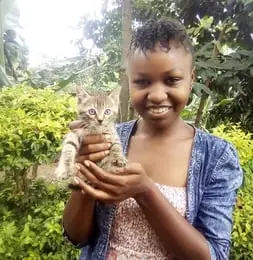
We all have different ways of showing affection to our pets. You probably enjoying holding close your cute cat and kissing it.
If you are wondering whether your cat knows when you kiss it, keep reading to learn more about this topic.
I will tell you if your cat understands this gesture as a form of affection, how to know if they hate kisses, and what to do instead to show love to them.
The answer to whether cats know when you kiss them:
Your cat may know when you kiss it because its mother used to groom it. However, most cats don’t like kisses.
Bringing heads close is a thing reserved for trusted friends. Show love through slow blinks, body massages, and treats.
Don’t kiss your cat on its lips for health reasons.
Your Cat Understands Kissing as a Form of Affection
Your cat may understand that kissing is a form of affection. When a cat is born, it is met with its mother’s tongue. The queen licks its kittens as part of the grooming process and to bathe them.
It is a sign of love and protection. Cats also groom each other as an affectionate gesture, and a sign of social bond from an animal they trust. They might bump their nose or head on another animal.
So, when you kiss your cat, it may understand that you are showing it love. To know if your cat understands kisses or even loves them, you will see it leaning forward, rubbing its head against your while it purrs.
However, the fact that your cat knows when you kiss it does not mean it likes the gesture. The next section explains why this may be the case.
Your Cat May not Like you Kissing it
Bringing heads is a personal thing for your cat. Remember, that the fondness actions described above between cats are rarely shown among strangers. They will only bring their heads close together with cats they are well acquainted with.
If you kiss your cat and get no reaction at all, don’t be offended. Your cat has to trust you before it feels comfortable seeing your face so close. You might have to wait a bit longer to build trust before it likes your kisses.
Maybe it has been recently separated from its mother and littermates, and still feels lonely. However, as long as you have a good relationship with your cat, your little one might tolerate the action, and even reciprocate the love you are showing it.
You might want to start with a kiss from far. A kiss from a cat’s perspective is making eye contact, and slowly blinking to show trust and friendliness. If they do that, respond to the “kiss” by slowly blinking back.
Your Cat’s Reaction Depends on its Personality

Before you bring your face close to your cat, consider its personality. Some cats are very shy, nervous, and don’t like to be constrained.
Other cats are friendly and very approachable, ready to cuddle up in your arms wherever they see you.
What determines your cat’s personality depends on its parents, how much handling it had, at what age, and any other experiences it had while still young. All these things happen before you take your kitten.
That’s why it’s important to check out these qualities before you bring your cat home. At the shelter home, look for one that is happy to be around people and ready to interact with you.
Don’t Kiss your Cat on the Lips for Health Reasons.
No matter how much you love your cat, don’t kiss it on the lips for health reasons. There are several diseases you can catch from their mouth. These are:
- Common bacteria: E. Coli, Pasteurella, and Salmonella are highly contagious bacteria that you can catch from kissing your cat.
- Ringworm: This is a fungal infection that can be passed from cats to humans.
Your cat may also eat small insects that can harbor diseases. Therefore, to be on the safe side, it’s important to avoid kissing your cat on the lips. A peck on the head is enough, and it serves the same purpose.
Besides, kissing your little one on the lips might be just too much of an invasion of its space.
Quick Tips when Handling Your Cat
- Only kiss your cat’s head when it is relaxed and in a calm mood.
- Do not kiss it on the lips.
- Wash hands thoroughly with soap and water after holding your cat and before handling food.
- Visit the vet regularly to keep them up to date with vaccinations.
- Treat your cat for fleas and parasites.
There Are Other Ways to Show Them Affection
Not all cats will love head rubs or pecks. If your kitten responds negatively to your kisses, put its ears back, move away, and respect its personal space.
This, however, does not mean you cannot show love to your cat. Here are ways you can show love and bond in the process:
1. Slow blinks

As you are relaxing with your cat, you might have noticed it is staring at you lazily and slowly blinks its eyes. According to cat behaviorist, Pam Johnson-Bennett, these slow blinks are your cat’s version of a kiss.
You can slowly blink back at your furry friend to show that you love it. This is a good way to communicate with your cat.
2. Body Massage

Your cat loves massages. Stroke your cat from its head to tail to make your little one feel relaxed and loved.
Cats like to be stroked under the chin and at the base of the tail. Pay attention to these areas when you are massaging them.
You can also use a soft brush to comb your cat’s fur. Your cat spends a lot of time grooming, and it is something it learned from its mother. So, it will appreciate the help you are giving it.
The brush feels good on its body, and it serves as a bonding session between you and your feline companion.
3. Cat treats
Cats love treats. As long as you offer it in moderation, treats are a nice way to reward them for being a behaved furry friend, and also a nice way to be friendly.
Cat treats help you bond with your pet as you train it to do acceptable behavior. When your cat uses its scratching post instead of clawing on your curtains, give it a treat, and your little one will associate the sweet treats with the action.
Catnip makes a fine treat, and it has low-calorie content meaning your cat won’t have to deal with overweight issues.
Here are tips to keep in mind when using kitty treats to bond with your furry friend:
- Be moderate: If you give too many treats, your cat can develop a preference for them and avoid its food. Give your cat treats not more than 3 times a week.
- Avoid toxic foods: Examples of toxic foods to avoid giving your cat as treats are raisins, grapes, onions, and salty snacks. Check with your vet to ensure a treat is safe before offering it to your feline companion.
- Take it easy with ‘people food’: Human food is not completely bad for your cat. Occasionally, you might give it small bits of cooked tuna, fish, or cheese. However, remember that kitten food is better because it is formulated to contain vitamins, minerals, and amino acids your pet needs to stay healthy.
- Don’t replace treats with love: Your cat needs more than just treats for it to feel loved. It needs a safe home and loving attention. Treats cannot replace these needs. Spend more time cuddling, petting, and playing to bond with your cat.
4. Enrich its environment with play
Play enriches their lives and helps to relieve stress and boredom. Play is also important for your cat to help stay mentally alert and physically fit.
Your cat will love to chase, hide, pounce, and climb while playing. Therefore, ensure these activities are included in your sessions to keep your cat fully entertained.
Here are examples of such toys:
Toys for hiding
- Cardboard boxes.
- Empty paper bags.
- Tunnels.
- Empty toilet roll.
Toys to chase and swipe
- Strings.
- Feather teasers.
- Laser beam.
Toys to climb
- Cat tree.
- Scratching posts.
It doesn’t have to be complicated. Any toy that looks like prey and can wiggle will excite them. Supervise your cat as it is playing to avoid injury.
5. Learn more about your cat’s personality
Before you know how to express love to your cat, it’s important to first learn its personality. Learn about the things that make your little one feel happy and comfortable.
Observing their body language will help in this regard. Watch your furry friend’s body posture when it is happy and when it feels uncomfortable. This will help you know how to better respond to its needs and strengthen your friendship.
